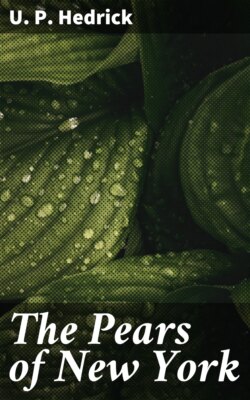Читать книгу The Pears of New York - U. P. Hedrick - Страница 38
На сайте Литреса книга снята с продажи.
BARTLETT
ОглавлениеTable of Contents
1. Downing Fr. Trees Am. 334, fig. 134. 1845. 2. Horticulturist 2:169. 1847–48. 3. Proc. Nat. Con. Fr. Gr. 29. 1848. 4. Hovey Fr. Am. 2:11, Pl. 1851. 5. Horticulturist N. S. 3:350, Pl. 1853. 6. Field Pear Cult. 190, 276, fig. 66. 1858. 7. Downing Fr. Trees Am. 666, fig. 1869. 8. Ont. Dept. Agr. Fr. Ont. 148, fig. 1914.
Williams’ Bon Chrétien. 9. Lindley Guide Orch. Gard. 350. 1831. 10. Prince Pom. Man. 1:137. 1831. 11. Hogg Fruit Man. 664. 1884.
Williams’ Apothekerbirne. 12. Dochnahl Führ. Obstkunde 2:181. 1856.
Bon Chrétien Williams’. 13. Pom. France 1: No. 16, Pl. 16. 1863. 14. Mas Le Verger 2:23, fig. 10. 1866–73.
Williams. 15. Leroy Dict. Pom. 2:758, fig. 1869.
Williams Christbirne. 16. Lauche Deut. Pom. II: No. 18, Pl. 18. 1882. 17. Mathieu Nom. Pom. 298. 1889.
Bartlett leads all other pears in number of trees in New York, and vies with Kieffer for the greatest number in America. Its fruits are more common and more popular in American markets than those of any other pear. When the characters of the variety are passed in review, although several poor ones of fruit and tree appear, the popularity of Bartlett with growers and sellers, if not with consumers, seems justified. As with the leading variety of any fruit, the preëminently meritorious character of this one is its great adaptability to different climates, soils, and situations. Thus, Bartlett is grown with profit in every pear-growing region in America and in all is grown in greater quantities than any other sort excepting, perhaps, the notorious Kieffer. Another character which commends this variety to pear-growers is fruitfulness—barring frosts or freezes, the trees bear full crops year after year. Moreover, the trees are very vigorous, attain large size, bear young, live long, are easily managed in the orchard, and thrive on both standard and quince stocks. The pears are large, handsome, of good but not of the best quality, and keep and ship remarkably well.
Bartlett is not without serious faults, however. The trees blight badly, and are not much above the average in resistance to blight, the black plague of the pear. Neither are they as hardy to cold or to heat as those of some other varieties. They are scarcely hardier to cold than those of the peach, and cannot withstand the summer heat of the southern, or of the Mississippi Valley states. Another serious defect of the trees is that, more than those of any other standard variety, their blossoms require cross-fertilization. The fruits are satisfactory in all characters excepting quality. There are many better-flavored pears. The fruits lack the rich, perfumed flavor of Seckel on one hand, and the piquant, vinous taste of Winter Nelis on the other. But the pears are much above the average in quality, and since no other variety is so easily grown, nor so reliable in the markets, Bartlett promises long to continue its supremacy for home and commercial plantations. After Kieffer, it is the most desired of all pears by the canning trade. Bartlett is the parent of several other well-known varieties, and of many sorts of small importance.
This pear was found as a wilding by a Mr. Stair, a schoolmaster at Aldermaston, Berkshire, England. From him it was acquired by a Mr. Williams, a nurseryman at Turnham Green, Middlesex, and as it was propagated and distributed by him it became known by his name, although it is still known as Stair’s pear at Aldermaston. It was brought to this country in 1797 or 1799 by James Carter of Boston for Thomas Brewer who planted the variety in his grounds at Roxbury, Massachusetts, under the name of Williams’ Bon Chrétien, by which name it was then and still is known both in England and France. In 1817 Enoch Bartlett, Dorchester, Massachusetts, became possessed of the Brewer estate, and not knowing its true name allowed the pear to go out under his own. Henceforth it was known in America as Bartlett. The American Pomological Society added this variety to its catalog-list of fruits in 1848.
Tree medium in size, tall, pyriform, upright, hardy, very productive; branches stocky, smooth, reddish-brown overlaid with ash-gray scarf-skin, with few lenticels; branchlets short, with short internodes, reddish-brown, glossy, smooth, glabrous, with conspicuous lenticles.
Leaf-buds short, obtuse, pointed, mostly free; leaf-scars prominent. Leaves 2¾ in. long, 1⅖ in. wide, oval, leathery; apex taper-pointed; margin tipped with small dark red glands, finely serrate; petiole 1¾ in. long. Flower-buds large, conical, pointed, free; flowers showy, 1¼ in. across, in dense clusters averaging 7 buds in a cluster; pedicels 1⅛ in. long, slender, slightly pubescent.
Fruit matures in September; large, 3⅜ in. long, 2⅜ in. wide, oblong-obtuse-pyriform, tapering toward the apex, symmetrical, uniform; stem 1⅛ in. long, often curved, thick; cavity small, usually lipped, with thin, overspreading streaks of light russet, acute, shallow; calyx partly open; lobes separated at the base, narrow, acute; basin very shallow, narrow, obtuse, furrowed and wrinkled; skin thin, tender, smooth, often dull, the surface somewhat uneven; color clear yellow, with a faint blush on the exposed cheek, more or less dotted with russet and often thinly russeted around the basin; dots many, small, conspicuous, greenish-russet; flesh fine-grained although slightly granular at the center, melting, buttery, very juicy, vinous, aromatic; quality very good. Core large, closed, with clasping core-lines; calyx-tube long, wide, funnel-shaped; seeds wide, plump, acute.
